Topography, gravity and a Corten-clad design by Tom Kundig at an award-winning new winery
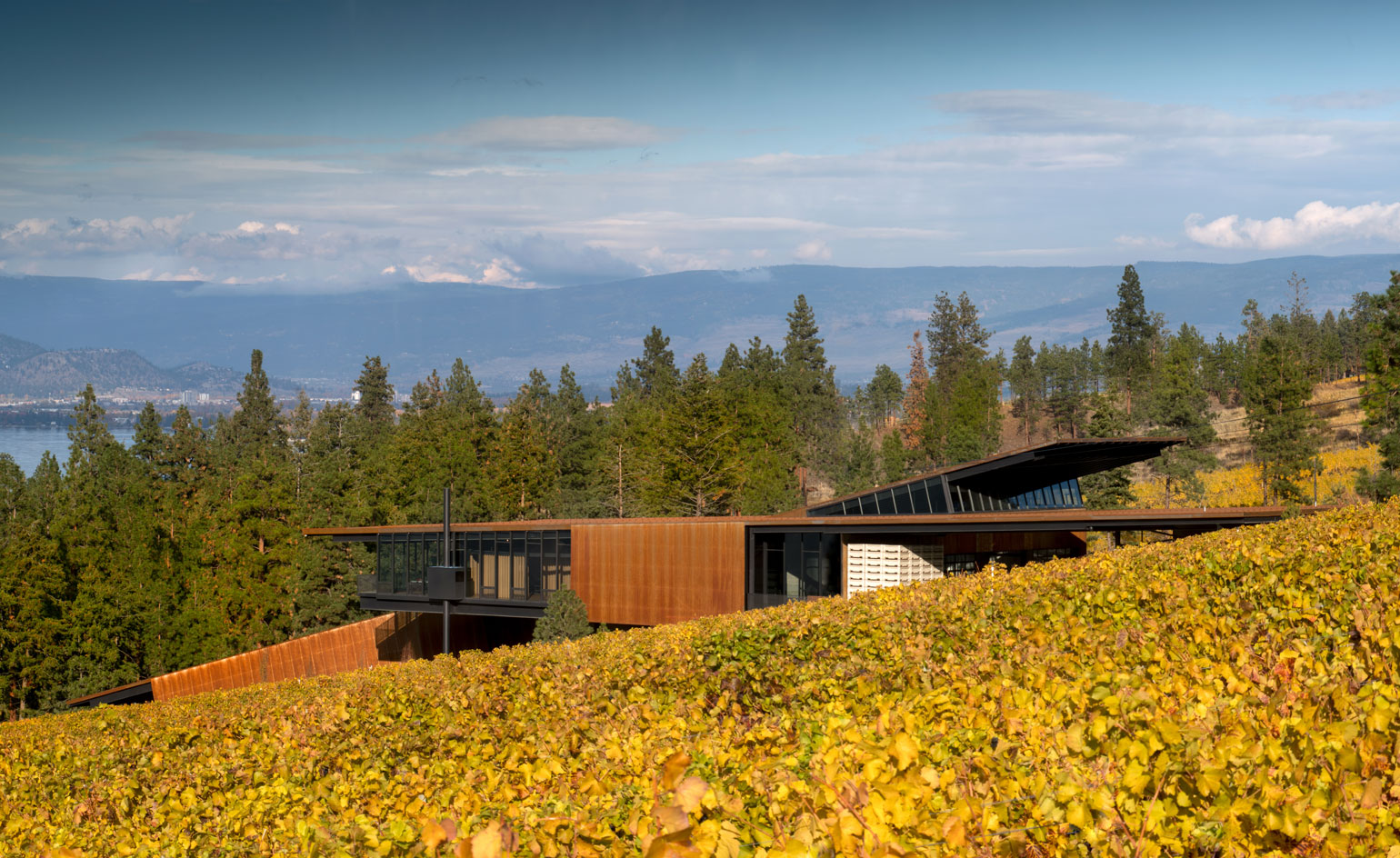
Tucked into a steep hillside in Kelowna, British Columbia, is the striking glass, steel and concrete structure of Martin’s Lane Winery, the producer of award-winning Pinot Noir and Riesling wines that draw discerning enthusiasts worldwide. A ‘gravityflow’ winery (designed on different levels to allow wine to flow, rather than be pumped, from one stage of the production process to the next, gently extracting colour, flavour and tannin from the grape skins), the project is testament to proprietor Anthony von Mandl’s commitment to the local Okanagan region, hailed as the next Napa Valley.
Martin’s Lane is von Mandl’s latest venture with architect Tom Kundig of Seattle practice Olson Kundig. The pair’s first collaboration delivered the nearby Mission Hill Winery, which opened some 20 years ago and was instrumental in putting the region on the vinicultural map. The pair have established a trust and understanding, allowing Kundig the freedom to come with the adventurous design of Martin’s Lane. The new building is a showcase for agility, quality, and craftsmanship. Kundig’s inspired initial sketch, penned in February 2014, was immediately green-lit and led to fast-track production schedule. The winery’s inaugural vintage – a 2014 Pinot Noir, awarded an unprecedented (for a debut) 97 points by leading wine expert Steven Spurrier – was produced while the building was still under construction.
Completed in summer 2016, the understated building veers from Mission Hill’s imposing, monastic scale with a more internalised, rational approach. It reads as a simple rectangular form split between a large production area, which follows the contours of the sloping site, and a smaller visitor area, which follows the horizon and overhangs the vineyard. The seam between the two areas is filled with clerestory windows that draw daylight into the layered interior. ‘There’s a real push and pull to how the winemaker sees this building functioning, the type of wine and style it is making, and how it fits into the slope,’ says Kundig of the need to strike a balance between the design intent, functional requirements, and environmental fit.
Designed as a series of tiers, Martin’s Lane tells the story of the gravity-flow winemaking process. The production stages step down the hillside, with grape-receiving and crushing areas at the top; fermentation and settling rooms; the bottling room; and finally, the barrel storage area, encased within the hillside. The earth provides ideal, stable temperatures and humidity without the need for conventional heating or cooling systems. The gravity-flow method is ideal for less forgiving, thin-skinned grapes. It is also inherently efficient: from grape to bottle in five movements, eschewing pumps and added yeasts in order to capture the absolute natural expression of the terroir. While gravity does the work, innovative technologies bring flexibility. Most of the tanks can be moved and replaced as needs change, and each can be monitored remotely.
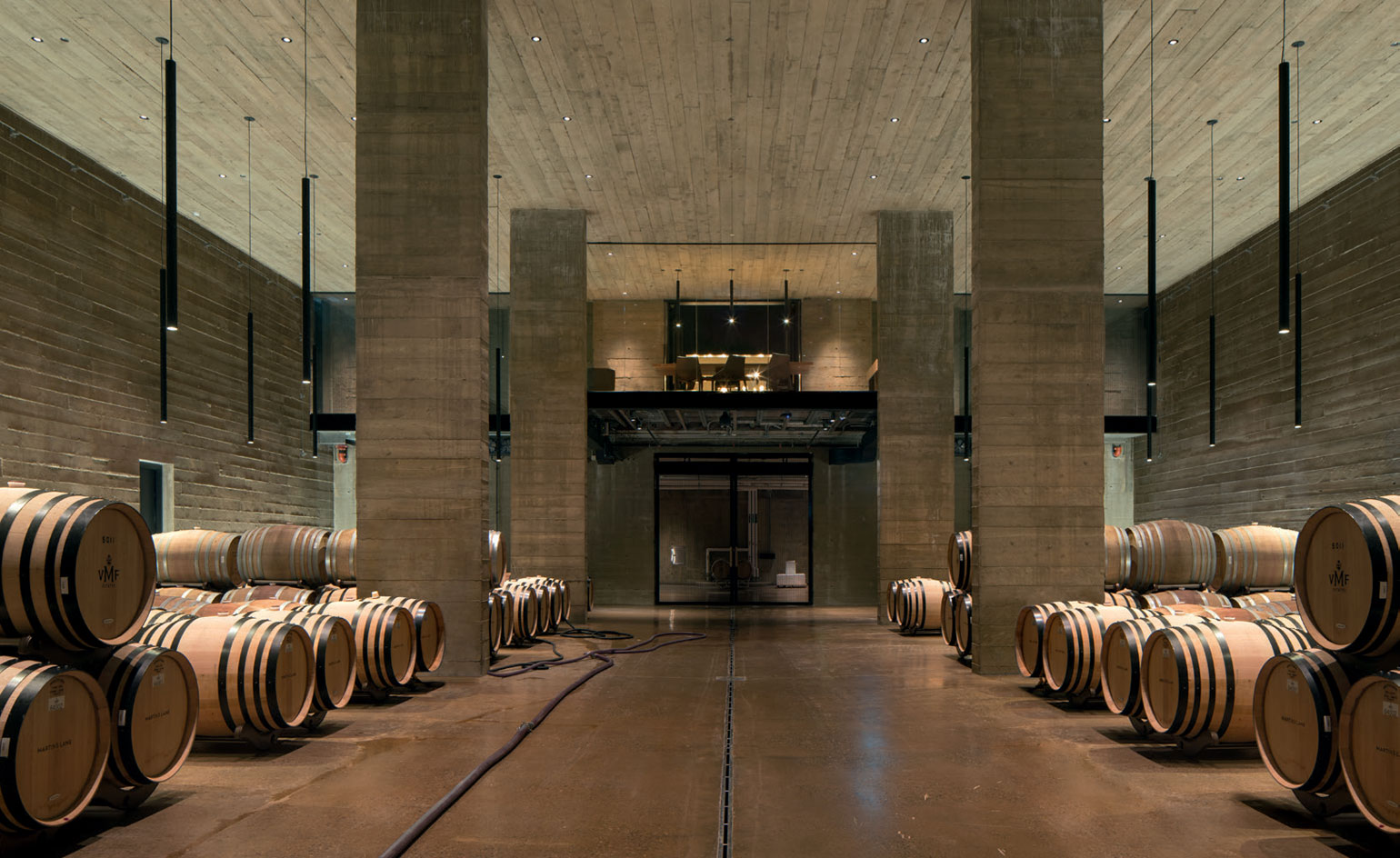
The primary barrel room, lined with board-formed concrete and with a glassed tasting area above, is set into the earth, for stable temperature and humidity
Visitors enter the winery through a tunnel and then emerge into a naturally lit hall. The building, like the wine, doesn’t give away everything at once. Little surprises and new experiences greet you as you round a corner, follow an underground passage or a raised pathway, or simply open a door. Descend into a rough board-formed concrete barrel-cellar for an immersive sensory experience. Survey the vast cellar from a glass-enclosed private tasting room. Delve deeper into the earth towards an events space with a floor of exquisite glass mosaic tiles. A freestanding spiral staircase, designed following the Fibonacci sequence to mimic vine growth, leads back to the surface. Here, one is offered glimpses inwards back into the production area, and outwards onto a cantilevered deck with views of the valley and Okanagan Lake.
Building materials are both tough and flexible. The armature is obsidian-painted structural steel. The skin and roofing is a corrugated, weathering Corten – a nod to the area’s agricultural heritage. Sustainability is driven by the desire for authenticity and simplicity. Not only does Martin’s Lane minimise energy consumption by using the earth as a heat sink, its topographical placement and orientation helps funnel cool lake air through the building, providing natural ventilation. Completing the earth, wind, water trinity, rain collected on the split roof is diverted to an organic garden and animal habitat down the hill.
Kundig is a nimble architect who appears unconstrained by ego, able to work effortlessly with numerous collaborators. He and von Mandl worked hard to assemble a team of local artisans and international designers. A local racecar builder contributed to the engineering of a 33ft sliding window, which is operated by a chain-driven handwheel. Catalan architect Antoni Puig fashioned sets of motorised 1,200lb doors that incorporate a fold echoing the seam through the building. The massive doors open silently and gently, while their blackened steel surface recalls a devastating fire that still scars the nearby trees.
Wallpaper* Newsletter
Receive our daily digest of inspiration, escapism and design stories from around the world direct to your inbox.
Ultimately, the building is an expression of von Mandl’s exacting standards and dedication to the Okanagan soil. It is also a study in contrast and collaboration. Its compressed design schedule seems at odds with the staid, centuries-old gravity process. Yet Kundig’s design has an air and poise that ensures visitors’ senses are appropriately focused on the wine. The structure impressed onto the striking hillside does not impose. Its edited architecture slowly reveals itself, and allows interpretation and discovery. ‘Like wine, the more nuance you can build into a building the more you can appreciate it over time,’ says Kundig.
As originally featured in the July 2017 issue of Wallpaper* (W*220)
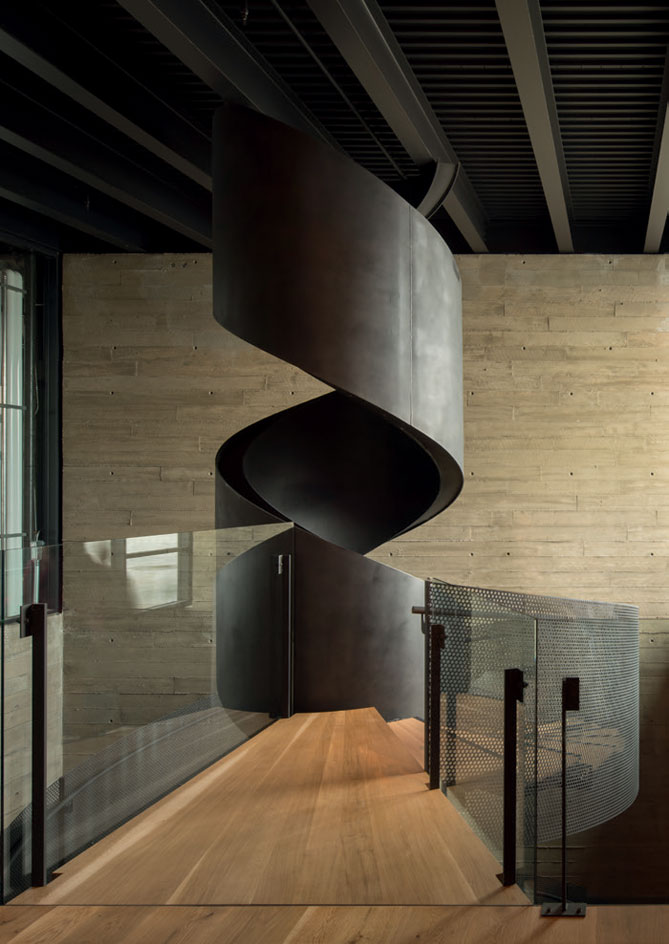
A spiral staircase mimics vine growth
INFORMATION
For more information, visit the Martin Lane Winery website and Olson Kundig Architects website
-
 All-In is the Paris-based label making full-force fashion for main character dressing
All-In is the Paris-based label making full-force fashion for main character dressingPart of our monthly Uprising series, Wallpaper* meets Benjamin Barron and Bror August Vestbø of All-In, the LVMH Prize-nominated label which bases its collections on a riotous cast of characters – real and imagined
By Orla Brennan
-
 Maserati joins forces with Giorgetti for a turbo-charged relationship
Maserati joins forces with Giorgetti for a turbo-charged relationshipAnnouncing their marriage during Milan Design Week, the brands unveiled a collection, a car and a long term commitment
By Hugo Macdonald
-
 Through an innovative new training program, Poltrona Frau aims to safeguard Italian craft
Through an innovative new training program, Poltrona Frau aims to safeguard Italian craftThe heritage furniture manufacturer is training a new generation of leather artisans
By Cristina Kiran Piotti
-
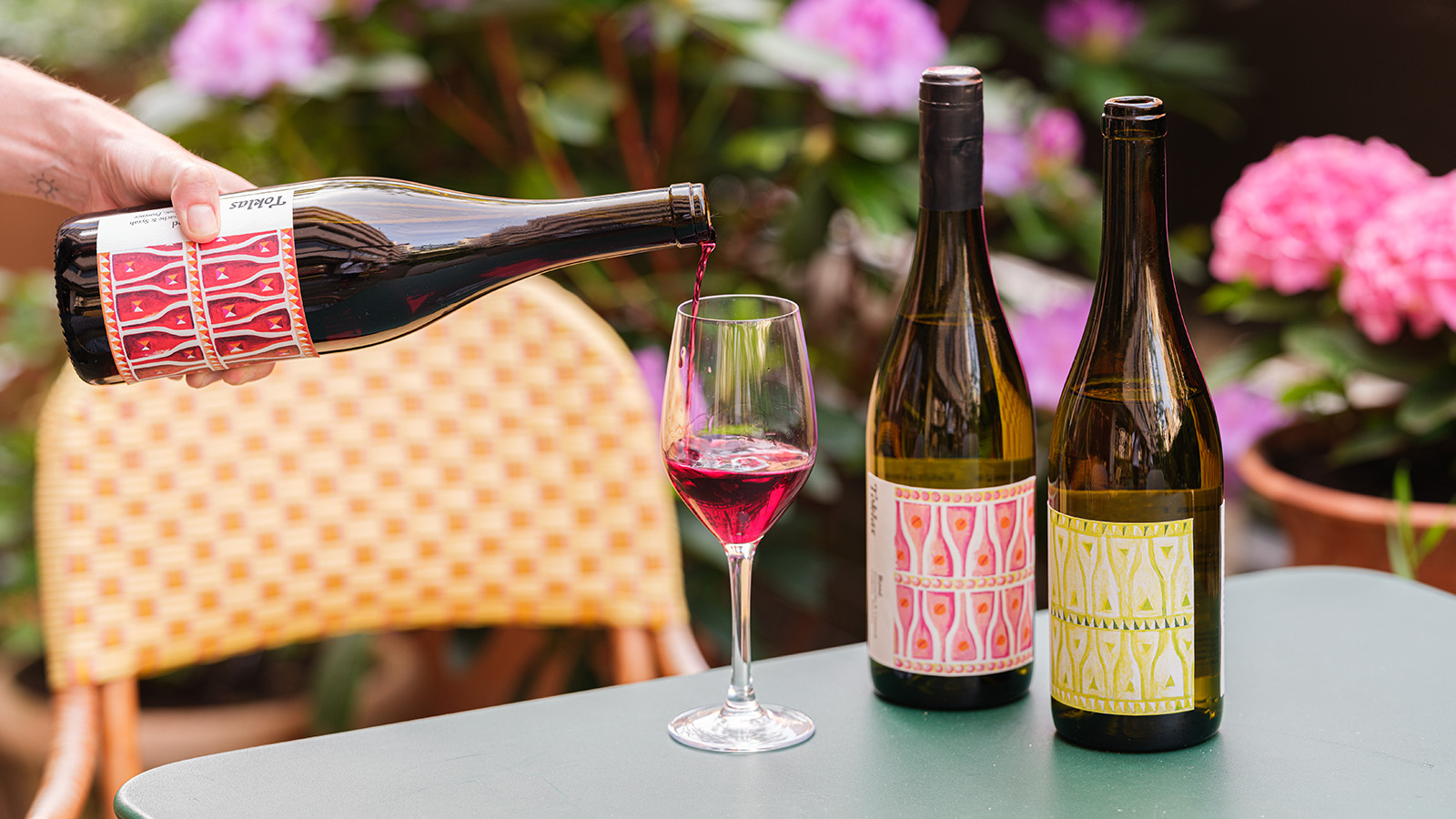 Toklas’ own-label wine is a synergy of art, taste and ‘elevated simplicity’
Toklas’ own-label wine is a synergy of art, taste and ‘elevated simplicity’Toklas, a London restaurant and bakery, have added another string to its bow ( and menu) with a trio of cuvées with limited-edition designs
By Tianna Williams
-
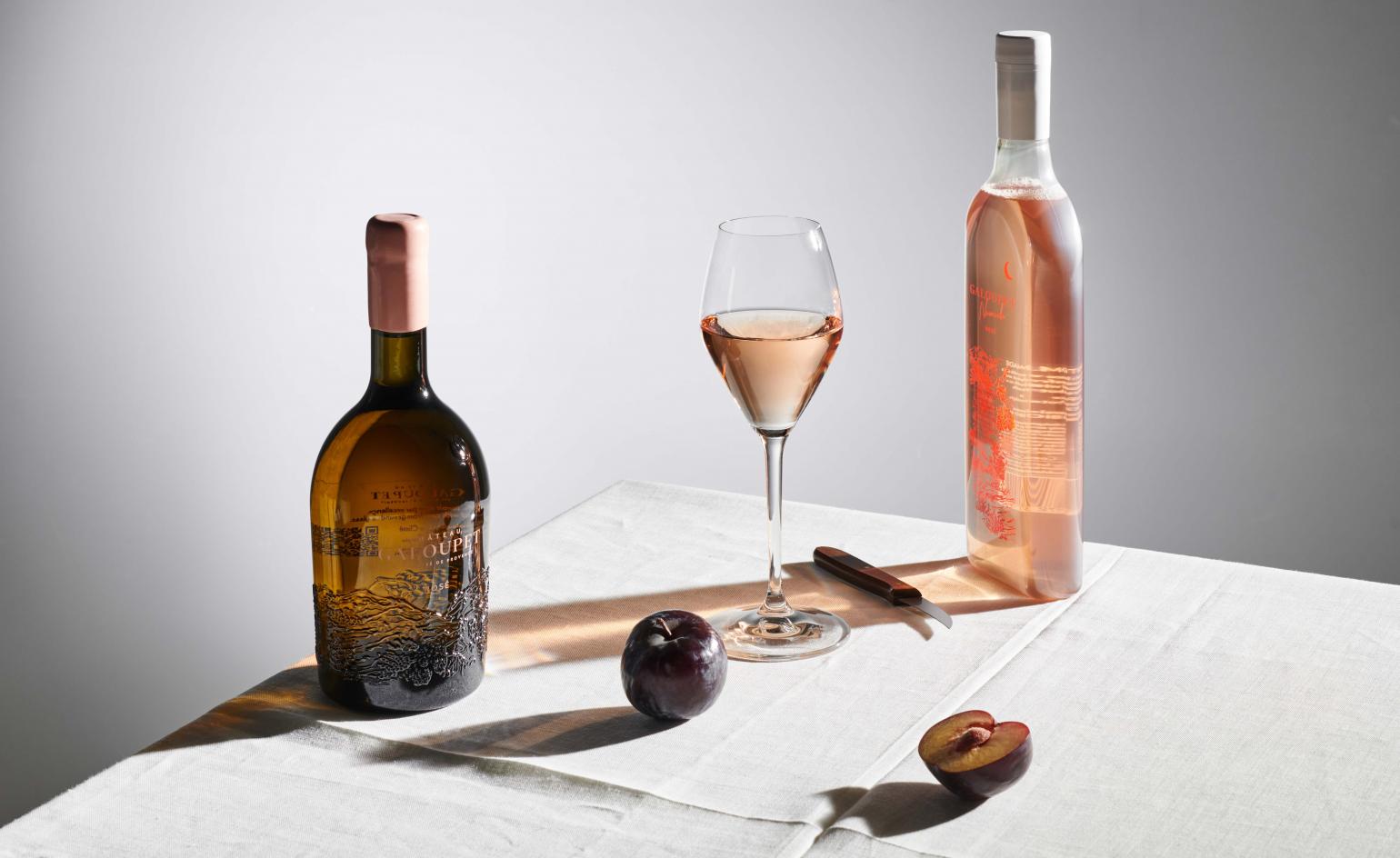 Château Galoupet is teaching the world how to drink more responsibly
Château Galoupet is teaching the world how to drink more responsiblyFrom reviving an endangered Provençal ecosystem to revisiting wine packaging, Château Galoupet aims to transform winemaking from terroir to bottle
By Mary Cleary
-
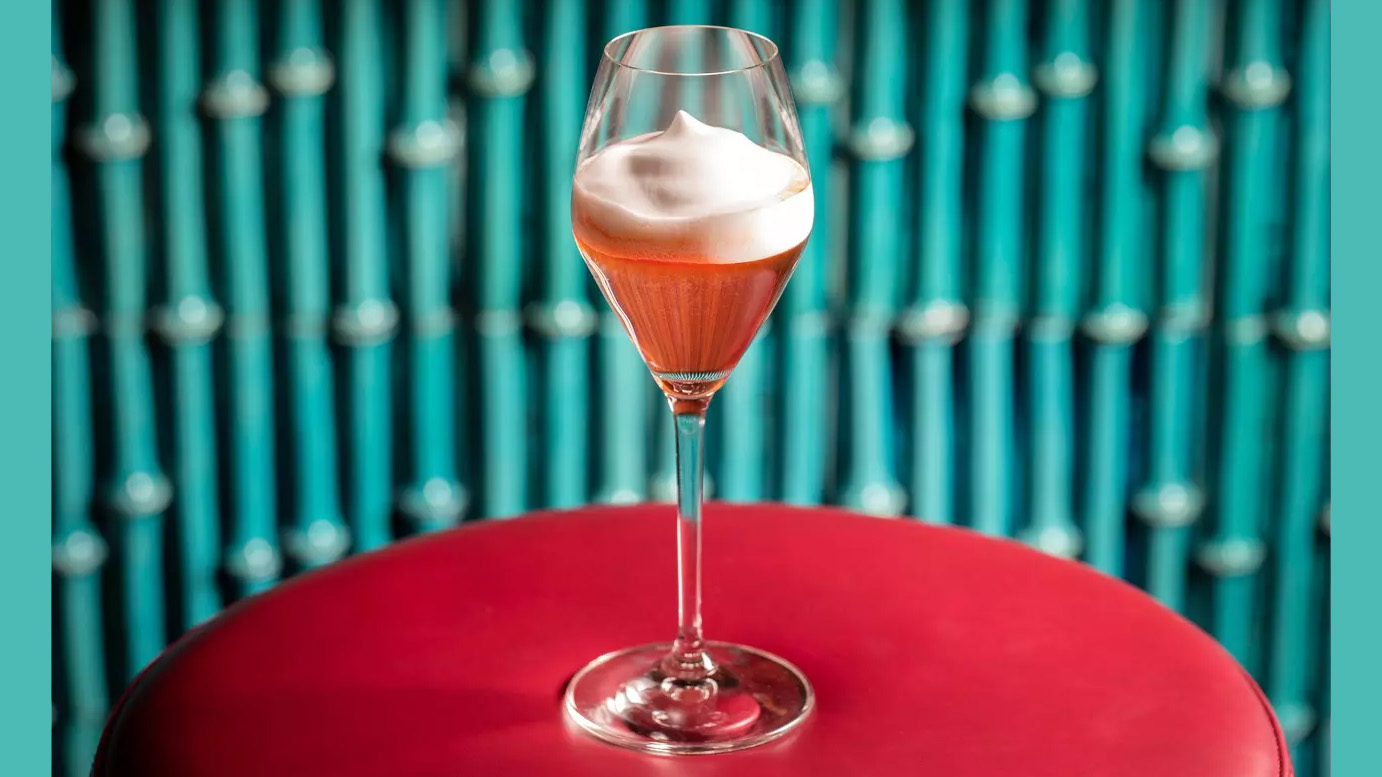 London’s most refreshing summer cocktail destinations
London’s most refreshing summer cocktail destinationsCool down in the sweltering city with a visit to London’s summer cocktail destinations
By Mary Cleary
-
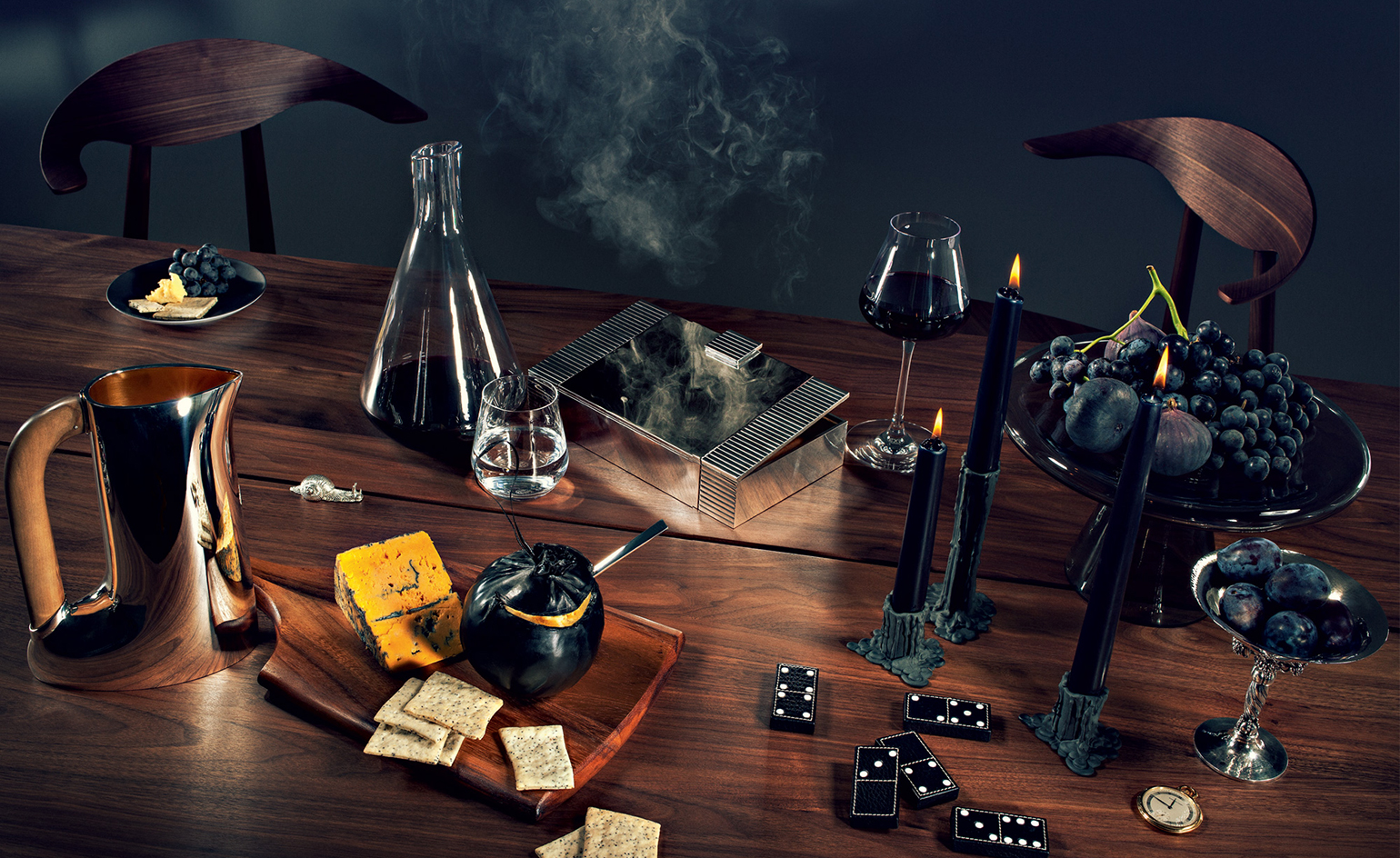 Learn how to curate a simple cheese board with perfect port pairings
Learn how to curate a simple cheese board with perfect port pairingsThe experts at artisan cheesemonger Paxton & Whitfield share tips for curating a simple but sophisticated cheese board, with port and cheese pairings for every taste
By Melina Keays
-
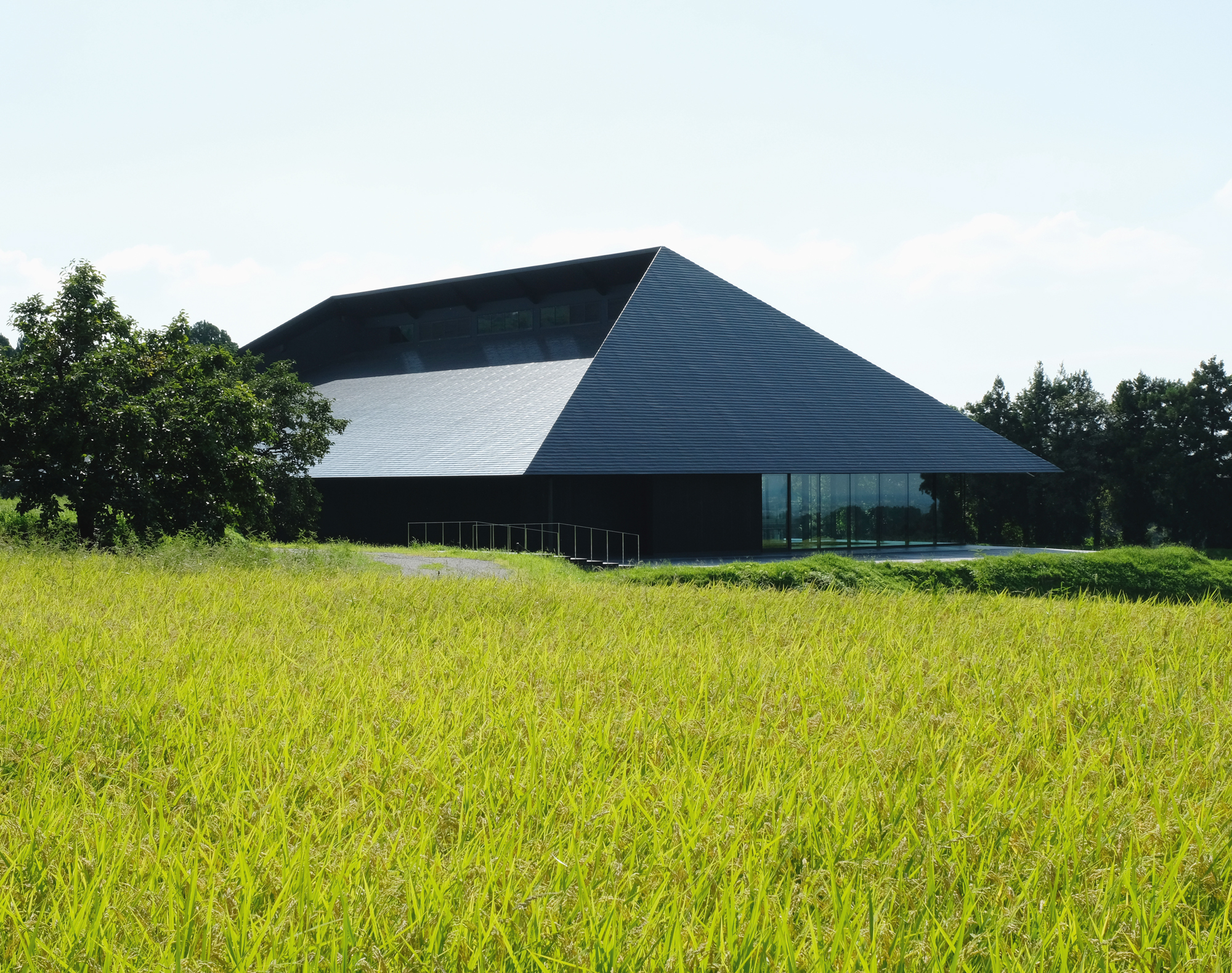 IWA sake brewery by Kengo Kuma is Best Roofscape: Wallpaper* Design Awards 2022
IWA sake brewery by Kengo Kuma is Best Roofscape: Wallpaper* Design Awards 2022IWA sake brewery in Japan, by Kengo Kuma & Associates, scoops Best Roofscape at the Wallpaper* Design Awards 2022
By Tony Chambers
-
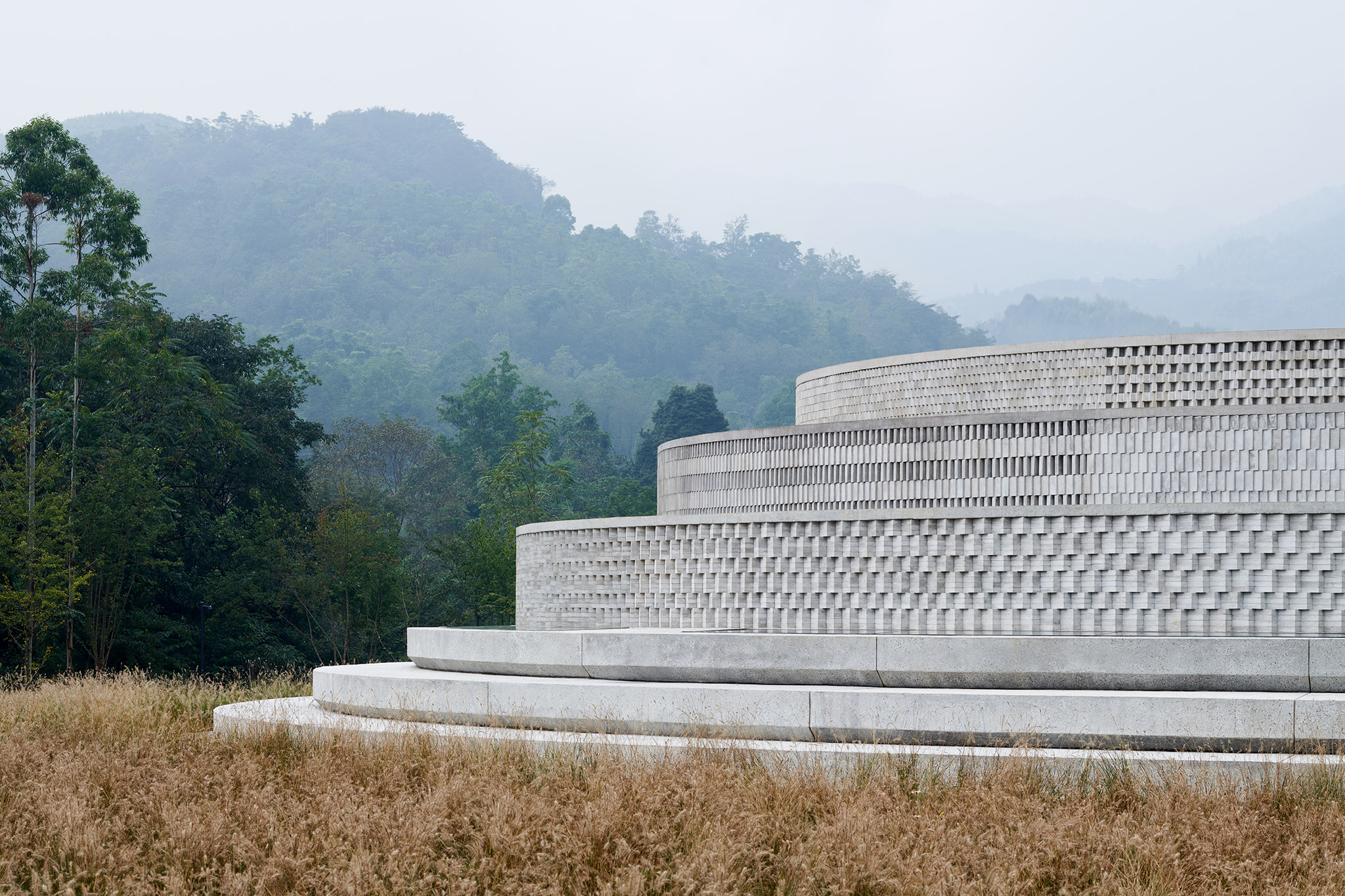 The Chuan Malt Whisky Distillery by Neri & Hu offers a twist on Chinese tradition
The Chuan Malt Whisky Distillery by Neri & Hu offers a twist on Chinese traditionNeri & Hu designs headquarters for The Chuan Malt Whisky Distillery in China's Sichuan province
By Yoko Choy
-
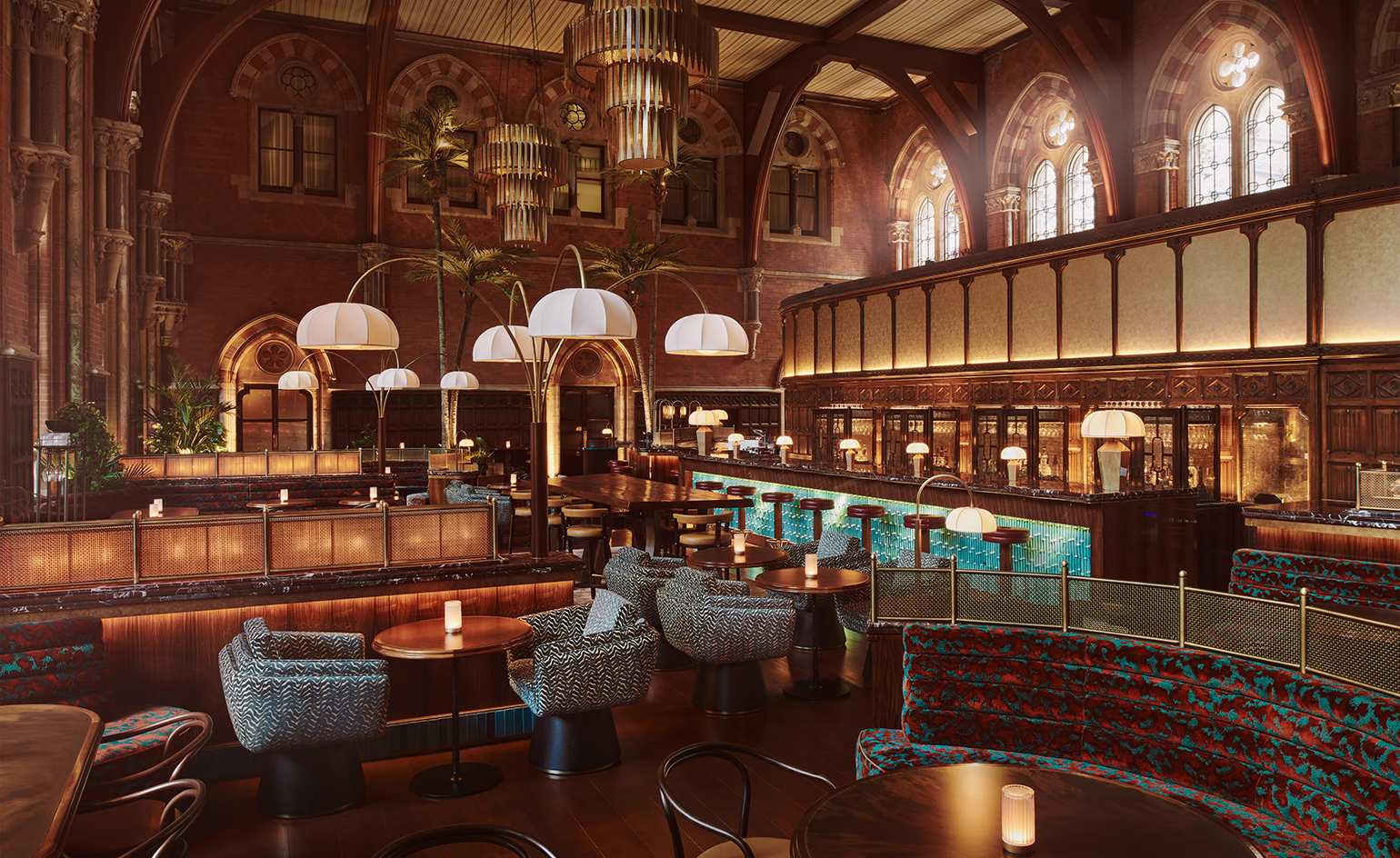 St Pancras Renaissance Hotel opens Booking Office 1869 restaurant
St Pancras Renaissance Hotel opens Booking Office 1869 restaurantBooking Office 1869 restaurant, at the St Pancras Renaissance Hotel, is set to become a new London hotspot. Developer Harry Handelsman and designer Hugo Toro tell us about its creation
By Mary Cleary
-
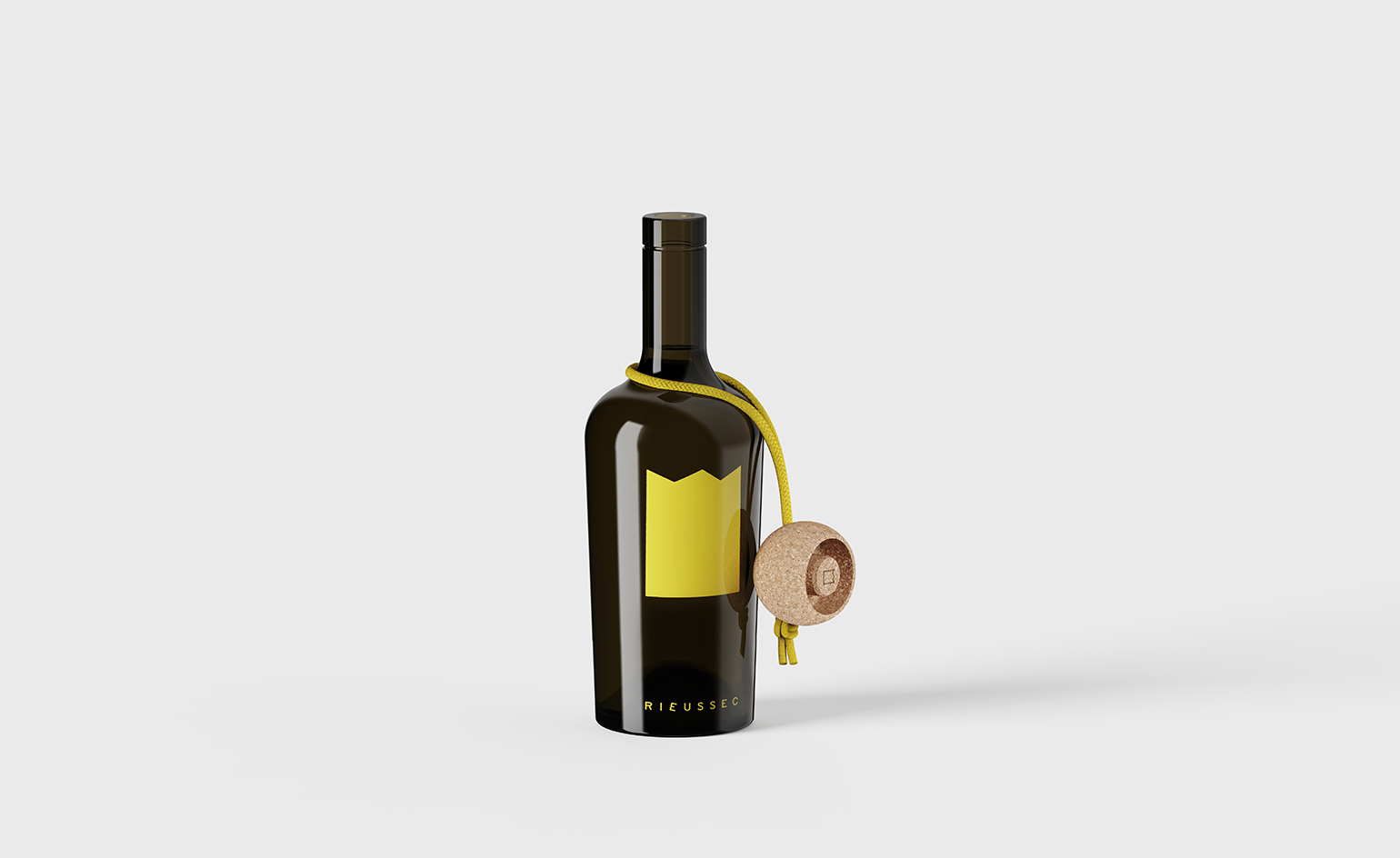 Sweet Sauternes: France’s forgotten wine gets a reputational makeover
Sweet Sauternes: France’s forgotten wine gets a reputational makeoverSaskia de Rothschild is on a mission to revive the popularity of Sauternes white wine, with Rieussec, produced and packaged with a fresh, more sustainable approach
By Mary Cleary